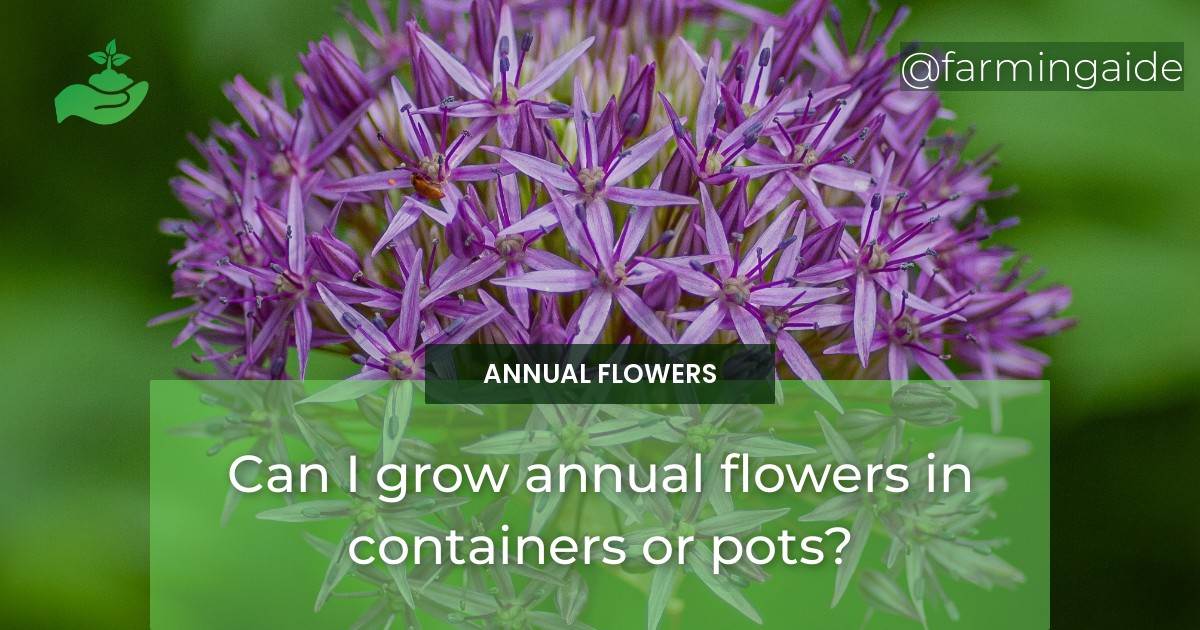Yes, you can grow annual flowers in containers or pots. In fact, growing annual flowers in containers is a fantastic way to enjoy beautiful blooms without having to worry about garden beds. Containers can be placed on balconies, patios, courtyards, and even indoors, making them an ideal choice for gardeners with limited space.
Tips for Growing Annual Flowers in Containers or Pots
Introduction to Growing Annual Flowers in Containers
Before we dive into the tips for growing annual flowers in containers or pots, let’s briefly discuss the advantages of container gardening.
Advantages of Growing Annual Flowers in Containers
Versatility of Containers
Containers come in a wide range of sizes, shapes, and materials, which means they can be tailored to suit any garden design or style. Plus, you can move them around as needed to create a constantly changing display of blooms.
Mobility
One of the biggest advantages of container gardening is that you can move your plants around to take advantage of the best growing conditions. This is especially important if you have a small garden or live in an area with limited sunlight.
Accessibility
Containers can be placed at a comfortable height, making them ideal for gardeners with mobility issues. Plus, they can be positioned close to the house or in other convenient locations, making it easier to care for your plants.
Pest Control
Container gardening can help you control pests and diseases since you have complete control over the soil and growing conditions. Plus, you can move your plants away from any infected areas to prevent the spread of disease.
Suitable Varieties for Growing Annual Flowers in Containers
Petunias
Petunias are a popular choice for container gardening due to their profusion of blooms and wide range of colors. They prefer well-draining soil and plenty of sun, making them ideal for containers.
Marigolds
Marigolds are another great choice for container gardening. They are easy to grow, come in a variety of colors, and help repel pesky insects like mosquitoes and aphids.
Geraniums
Geraniums are a classic container gardening plant. They prefer well-draining soil and plenty of sunshine, making them perfect for containers.
Pansies
Pansies are a cool-season flower that can be grown in containers during the fall and winter months. They come in a wide range of colors and prefer cooler temperatures.
Lobelia
Lobelia is a trailing plant that is perfect for hanging baskets and window boxes. It prefers cooler temperatures and plenty of water.
Soil Mixtures for Growing Annual Flowers in Containers
Components of the Soil Mixture
The soil mixture you use for container gardening should be well-draining and nutrient-rich. A good soil mixture should include a combination of peat moss, vermiculite, and perlite.
pH Level of the Soil Mixture
The pH level of the soil mixture is important for growing healthy plants. Most annuals prefer a slightly acidic soil with a pH level between 6.0 and 6.5.
Preparing the Soil Mixture
To prepare the soil mixture, simply mix together equal parts peat moss, vermiculite, and perlite. You can also add in some slow-release fertilizer to give your plants an extra boost.
Watering Requirements for Growing Annual Flowers in Containers
Frequency of Watering
Container-grown plants require more watering than those planted in the ground. You should water your plants at least once a day, or more often during hot, dry weather.
Checking the Moisture Level of the Soil
It’s important to check the moisture level of the soil regularly to ensure your plants are getting the right amount of water. Stick your finger into the soil up to the second knuckle. If the soil feels dry, it’s time to water your plants.
Methods of Watering
When watering your container-grown plants, use a watering can or hose with a gentle spray nozzle to avoid damaging the plants. You can also use a self-watering container or drip irrigation system to make watering easier.
Maintenance Tips for Growing Annual Flowers in Containers
Deadheading
Deadheading, or removing spent blooms, is important for encouraging your annual flowers to produce more blooms. Simply pinch off the dead flowers with your fingers or use a pair of pruning shears.
Fertilizing
Fertilizing your container-grown plants is important for healthy growth and blooming. Use a slow-release fertilizer, and follow the manufacturer’s instructions for application rates.
Pruning
Pruning is important for keeping your container-grown plants looking neat and tidy. Use a pair of pruning shears to remove any dead or damaged foliage, and to shape your plants as needed.
Is it Possible to Grow Annual Flowers in Small Spaces Such as Balconies or Patios?
Yes, it is very possible to have a thriving garden of growing annual flowers on balcony or patio spaces. With the right containers and soil, you can enjoy vibrant blooms all season long. Be sure to choose varieties that are well-suited for containers and pay attention to watering and sunlight needs.
Conclusion
Summary of Tips
- Choose versatile containers that are easy to move and accessible for gardening.
- Select suitable varieties for container gardening, including petunias, marigolds, geraniums, pansies, and lobelia.
- Use a well-draining soil mixture with a pH level of 6.0 to 6.5, and add in slow-release fertilizer as needed.
- Water your container-grown plants regularly, and check the moisture level of the soil often.
- Deadhead spent blooms, fertilize regularly, and prune your plants to keep them looking neat and healthy.
Final Thoughts
Growing annual flowers in containers or pots is a great way to enjoy beautiful blooms without a garden bed. With the right containers, soil, and watering schedule, you can grow a wide range of annual flowers in containers, no matter the size or location of your garden.


